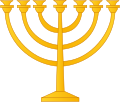
Back يهودية الهيكل الثاني Arabic يهودية الهيكل التانى ARZ দ্বিতীয় মন্দির ইহুদিধর্ম Bengali/Bangla Yuzevegezh an Eil Templ Breton Judaísmo del Segundo Templo Spanish یهودیت معبد دوم Persian Judaïsme du Second Temple French Giúdachas an Dara Teampall Irish Yahudi Bait Kedua ID 제2성전 유대교 Korean
| Part of a series on |
| Judaism |
|---|
   |
Second Temple Judaism is the Jewish religion as it developed during the Second Temple period, which began with the construction of the Second Temple around 516 BCE and ended with the destruction of Jerusalem in 70 CE. This period was marked by the emergence of multiple religious currents as well as extensive cultural, religious, and political developments among Jews. It saw the progression of the Hebrew Bible canon, the synagogue, and Jewish eschatology. Additionally, the rise of Christianity began in the final years of the Second Temple period.[1][2]
According to Jewish tradition, authentic prophecy (נְבוּאָה, Nevu'ah) ceased during the early years of the Second Temple period; this left Jews without their version of divine guidance at a time when they felt most in need of support and direction.[3] Under Hellenistic rule, the growing Hellenization of Judaism became a source of resentment among Jewish traditionalists who clung to strict monotheistic beliefs. Opposition to Hellenistic influence on Jewish religious and cultural practices was a major catalyst for the Maccabean Revolt against the Seleucid Empire. Following the establishment of the Hasmonean dynasty, traditional Judaism was reasserted by the Maccabees across the Land of Israel as they expanded their independent territory. The later years of the Second Temple period saw the development of several Jewish messianic ideas. From c. 170 BCE to 30 CE, five successive generations of the Zugot headed the Jews' spiritual affairs.
The late Second Temple period saw the emergence of several Jewish schools or groups. The Pharisees, a respected and influential group, believed both the Written Torah and ancestral traditions were equally binding and included members from both the priesthood and the general population.[4] The Sadducees, consisting of high priests and aristocrats, rejected the resurrection of the dead.[5] The Essenes criticized the temple's practices, deeming the priests illegitimate and the rituals flawed. They expected a victory of good over evil, with some members choosing to live in isolation.[5] Nonetheless, most Jews were not affiliated with any particular group and practiced common traditions such as observing the Shabbat, celebrating holidays, attending synagogue, making pilgrimages to the Temple, following dietary laws, and circumcising their newborn males.[6]
After the Temple's destruction in 70 CE, Judaism shifted away from temple-based rituals, including sacrificial worship, and adapted to a new framework without its sacred center. Jewish sectarianism disappeared,[7] while the Pharisees, later succeeded by the rabbis,[8] emerged as the leading force.[9] This transition focused on Torah observance, ethical deeds,[10] communal prayer, and rabbinical law, giving rise to Rabbinic Judaism, the dominant form since late antiquity.
- ^ Catherine Cory (13 August 2015). Christian Theological Tradition. Routledge. p. 20 and forwards. ISBN 978-1-317-34958-7.
- ^ Stephen Benko (1984). Pagan Rome and the Early Christians. Indiana University Press. p. 22 and forwards. ISBN 978-0-253-34286-7.
- ^ The Jewish Backgrounds of the New Testament: Second Commonwealth Judaism in Recent Study, Wheaton College, Previously published in Archaeology of the Biblical World, 1/2 (1991), pp. 40–49. [dead link]
- ^ Cohen 2014, pp. 161–162.
- ^ a b Cohen 2014, p. 160.
- ^ Cohen 2014, p. 171.
- ^ Cohen 1984, pp. 31, 35–36.
- ^ Cohen 2014, pp. 224–225.
- ^ Schaper 1999, pp. 426–427.
- ^ Safrai 1976, p. 318.
© MMXXIII Rich X Search. We shall prevail. All rights reserved. Rich X Search